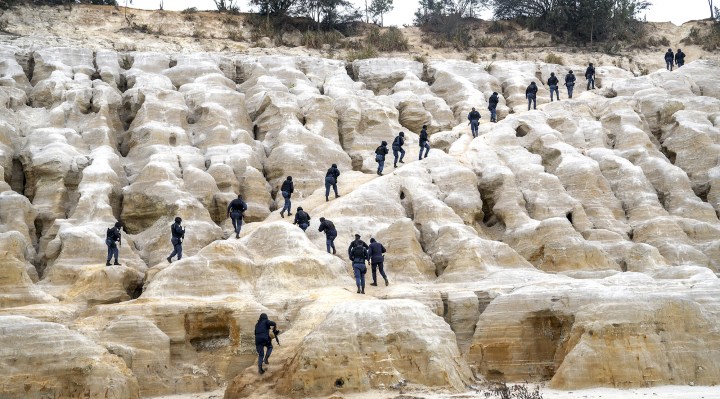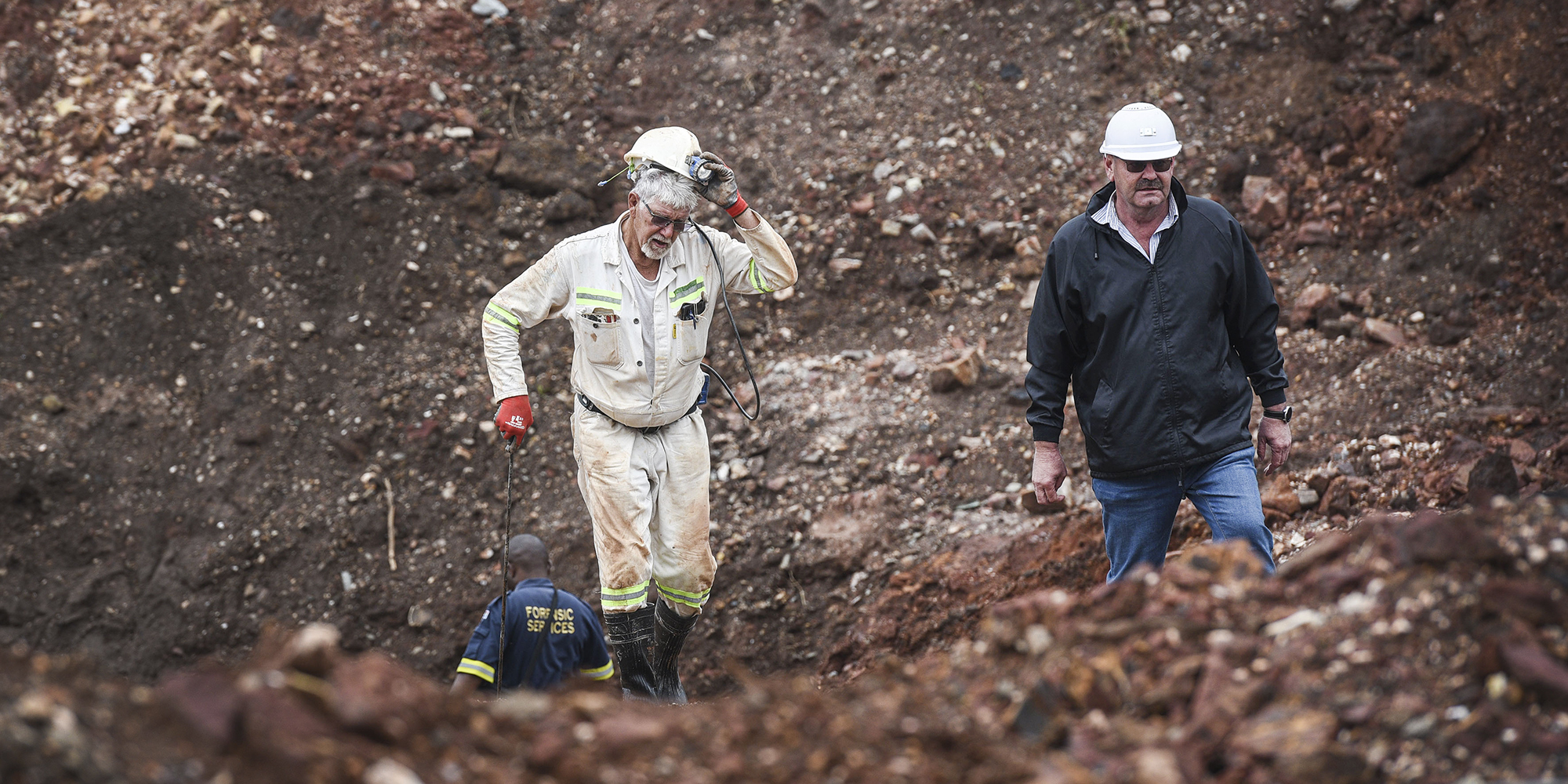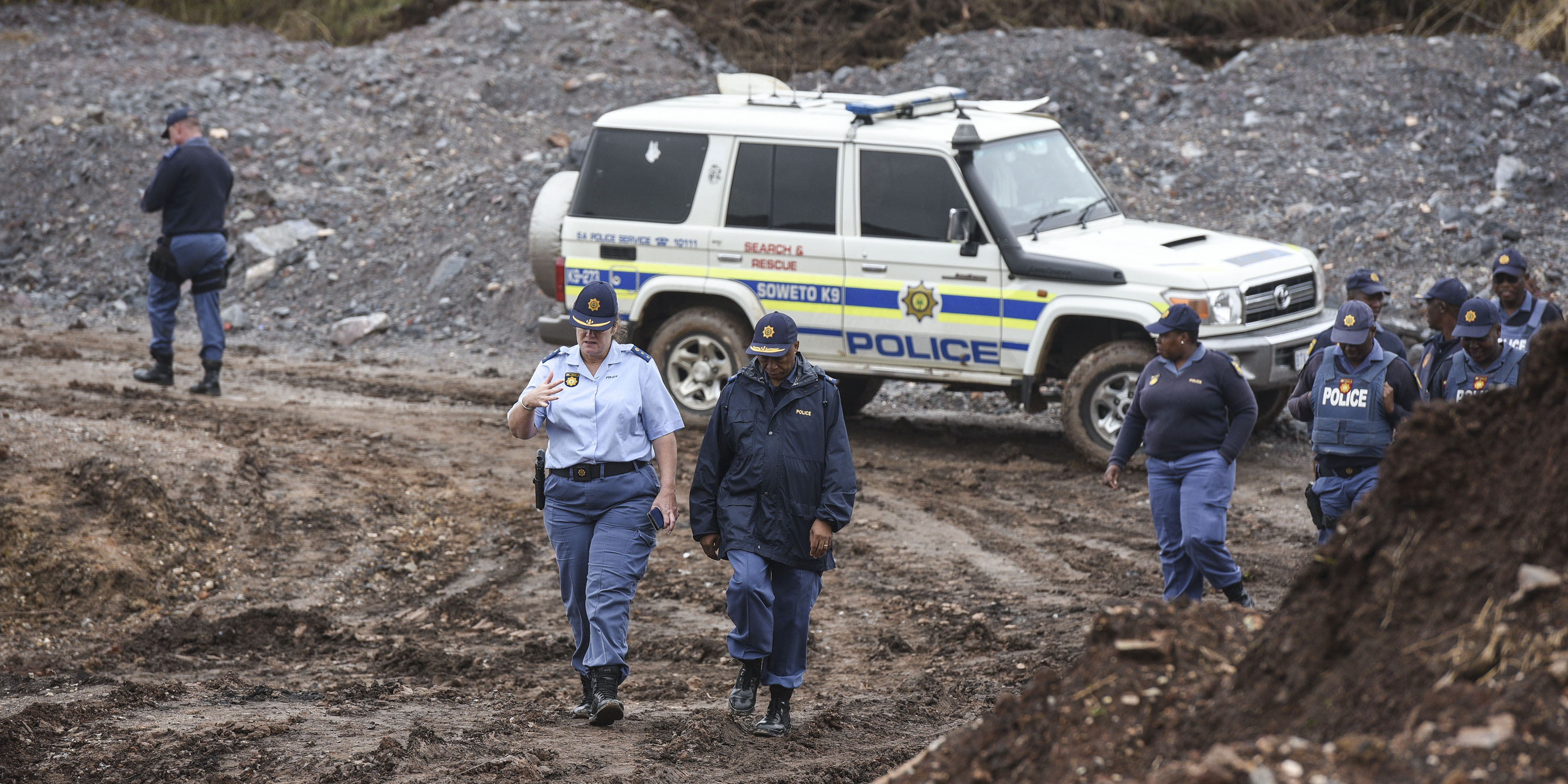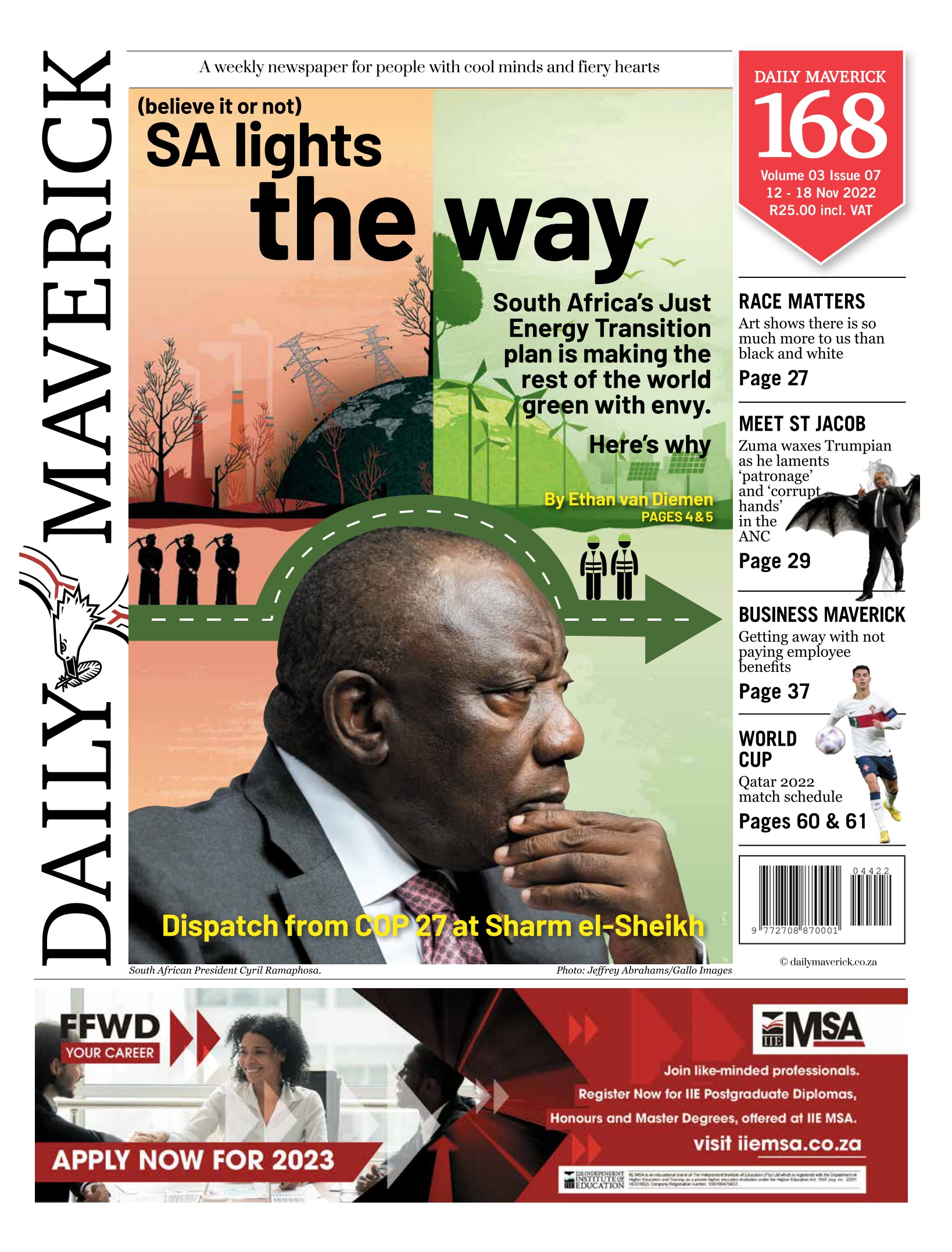HAZARDS OF WORK
Blood and gold – zama zamas dice with death in daily underground hell

This month, the bodies of 21 miners were found in a mineshaft in Krugersdorp. They are believed to be among tens of thousands of vulnerable and desperate men who risk going underground to make a living in some of the most perilous working conditions in the world.
‘I once prayed underground in Crown Mines,” said Tankiso, a “zama zama” from Lesotho who didn’t want his surname published. He got into illegal mining after working as an informal recycler, before developers took over the property where he and other recyclers were based and he started looking for a new income.
Down in the old Crown Mines operation one day, water and mud suddenly started flowing through the shaft where Tankiso was working. He tried to grip a rope to climb out but fell on his back. He waited for two days with 11 miners until other zama zamas finally came to the rescue.
Tankiso was speaking to DM168 in Krugersdorp alongside his colleagues Sello and Marshall, who are also from Lesotho and didn’t want their surnames published, not far from where 21 bodies of illegal miners were discovered earlier this month. Autopsy results are not yet forthcoming, but evidence suggests the bodies had been moved, although no foul play is suspected. It is believed they died when a trench collapsed due to heavy rains.

Emergency workers at the scene of the discovery of 21 bodies at a mine in Krugersdorp, early in November, 2022. Photo: Supplied
Caught in a harrowing web
The bodies of zama zamas frequently turn up near Johannesburg’s disused mines as tens of thousands of men go underground to make a living in some of the most dangerous working conditions in the world, without safety protections and at risk of criminal prosecution and gang violence.
Even very young zama zamas find themselves caught in the web of illegal mining and endure the same harrowing conditions as their older counterparts.
In a July 2022 report on South Africa’s unrehabilitated mines, Human Rights Watch (HRW) found that 312 informal miners had died between 2012 and 2015, 150 of them owing to “collapsing tunnels, gas poisoning, suffocation and explosion accidents”. Based on news reports, those figures were understated, said HRW – the police don’t officially record and rarely investigate zama zama deaths; miners, who operate illegally and are often undocumented, rarely report such cases.
“My motivation has always been that there is no greater danger than the struggles we have experienced. That is how I get through,” said Sello in Krugersdorp, who said zama zamas spend days, even weeks underground. “Normally, we have just enough food, because in some instances we can estimate how long we will be underground for.” Marshall added: “It’s as dangerous as anywhere and the money is very good.”
In a policy brief for ENACT, which seeks to enhance Africa’s response to transnational crime, artisanal mining expert Alan Martin said migrants come to South Africa looking for work because of crises in neighbouring countries. An estimated 70% of zama zamas are undocumented foreigners, according to the Minerals Council, which represents the country’s biggest mining companies.
The voices of zamas zamas are often ignored in the debate over illegal mining, but Maxwell Chuma interviewed workers for his 2021 PhD thesis at Wits. He found they had no alternative for income and were in the work due to poverty. He said informal gold miners sold their product at half the official price, while other reports suggest zama zamas sell at even a quarter of the price.

Police at the muddy scene of the latest mass tragedy, 10km from the nearest settlement, where the collapse of a trench as a result of heavy rain is believed to have claimed the lives of 21 illegal miners. Photo: Supplied
In his brief for ENACT, Martin said zama zamas “are exposed to extortion, murder, forced migration, money laundering, corruption, racketeering, drugs and prostitution”. He continued: “The exploitative conditions in which they work may be tough, but the small something they get for their labour is better than the nothing they were making in their home countries.”
Zama zamas are publicly synonymous with violence, known for underground warfare and wreaking havoc on nearby communities, but the stereotype ignores the complexities of the industry, which has a hierarchy of underground miners, gangs who prey on them, and buyers who sometimes oversee the work, as well as vast networks that profit the most from the multibillion-rand industry by sending the gold offshore.
Fear and hunger
The 2021 documentary We Are Zama Zama provided a rare insight into the lives of informal miners, including GoPro footage zama zamas shot of their claustrophobic and hazardous underground work. In the film, Rogers “Bakani” Mumpande said: “Where there’s gold, always, blood is there.”
Mumpande was trying to provide for his family with rudimentary tools in an extreme environment, but collapsing shafts weren’t his only fear. He said a gang had forced him at gunpoint to work underground for four days without food before being released. He quit the job when he resurfaced “but as time goes, hunger pushed me to go back”.
Residents are often reported to live in fear from gangs associated with zama zamas. Since the gang-rape of eight women in Krugersdorp in July by a group of men believed to be illegal miners, much focus has been on the deployment of the police and the local municipality’s response to the scourge of illegal mining. Last week, rape charges against 13 men and a minor, all suspected illegal miners, were dropped by the Krugersdorp Magistrates’ Court after DNA evidence could not link them to the rapes. They now only face charges relating to violating the Immigration Act.
Read in Daily Maverick: “Krugersdorp victim’s ordeal: ‘I closed my eyes, crying. Moments later, I was also raped, by three men’”
“We sleep with one eye open in West Village. Thugs call the shots in our area right under the noses of the police who take bribes,” said Krugersdorp resident Maria Jacobs. She added: “Illegal mining is a complicated issue for some in the community because we sell food to the illegal miners. Their operations provide a source of income for many in the community.”
Another resident, who wanted to remain anonymous, said: “If you don’t want zama zamas, the vendors will starve, the prostitutes will starve. We will all starve.”
Criminalised and stigmatised
Paps Lethoko, national coordinator of the National Artisanal Miners Association, said the criminalisation of the term “zama zamas” has led to stigmatisation. In isiZulu, the term loosely translates to “people who keep on trying”. Lethoko said the stigmatisation is discriminatory and fails to acknowledge a crucial economic sector.
“Our government is misleading the people, that when a black person is mining they are labelled criminal, but when a white person is mining there is no problem,” he said. “It’s illegal and irresponsible of the government to neglect the artisanal mining sector the way it has.”
Lethoko said current government policies criminalise and stigmatise the artisanal mining sector, which bolsters criminals and syndicates. He said former mining hubs have become ghost towns and that former mineworkers are also involved in illegal mining after they lost their jobs and had no other means of making an income.
Referring to the 21 bodies found in Krugersdorp, Lethoko said: “It’s very, very disappointing for our police to say that they do not suspect foul play, because by its very nature illegal mining is foul play.”
Tyrone Gray, executive mayor of Mogale City, recently addressed the media at the site in Krugersdorp where the bodies were found, saying residents would be equipped with knowledge that would enable them to report suspected illegal mining and other crime in the area.
“The best role of the community is to facilitate information… they are on the ground… they know what is going on in the community. So, we humbly implore that they share this information which will help us with smart information to realise our programmes of action. They will enjoy the same rights as whistle-blowers,” Gray said, without explaining what this would entail practically.
The area in Krugersdorp where the zama zamas operate and where the bodies were discovered is covered by piles of rocky sand. Heavy rain had turned some of it into mud, making the area difficult to access. The mining area was a clearing in the middle of a forest. The bodies were found about 10km from the closest township, where many illegal miners live, alongside the West Village community. A police officer at the scene said many illegal miners were believed to have been operating in the area and there was a strong possibility that more bodies could be found.
Gray said an inquest would be opened and the City would support it and make resources available for any investigation. He said illegal mining “runs all the way to Sinqobile. It’s a systemic issue in the whole of the West Rand. In this case, we are still waiting for the outcome of the commission’s inquiry; however, when it comes to rainfall it can easily flood tunnels and this is likely the outcome in this case.
“Illegal mining is incredibly dangerous. Many of the shafts are unsecured and it requires heavy machinery in order to rehabilitate the landscape.
Visit Daily Maverick’s home page for more news, analysis and investigations
“We constantly assist SAPS as well as all the mining houses and our public safety officials to rehabilitate the security network and inform the community that if they see something, say something.”
He said the illegal miners often infiltrated communities to the extent that they had become part of the underground economy. The municipality would investigate formalising artisanal mining, for the safety of the illegal miners and residents.
Gray added: “Illegal mining is a response to unemployment and avoiding the shackles of poverty. The departments, especially DMRE [Department of Mineral Resources and Energy], need to critically look at this and look at certain specialised economic and mining zones that we can roll out, both for the safety as well as the benefit of local communities.
“Illegal mining has been a systemic problem for a larger part of 15 years. So, it’s not something that we can solve in, say, six months; it will take constant engagement.”
The DMRE published an Artisanal and Small-Scale Mining Policy in March 2022 that recognises the potential of small-scale operators, but it effectively endorses the securitised approach to most informal mining and adds impetus to the criminalisation of zama zamas. It reserves a proposed permit system for South Africans.
Lethoko said the process of developing the policy was inadequate for artisanal miners, mainly because it was embarked on during the Covid-19 lockdown, meaning public participation took place on virtual platforms.
In the absence of a coherent policy to incorporate informal miners into the formal economy, the government and the established mining industry repeatedly talk about using force to combat zama zamas, with Police Minister Bheki Cele promising a crackdown on illegal mining kingpins. Cele has denied that cops are colluding with zama zamas, but in Krugersdorp the police are seen as part of the problem.
Speaking about the police, resident Nonhle Khumalo told DM168: “They cannot arrest the same people on whose bribes they survive.” DM168
This story first appeared in our weekly Daily Maverick 168 newspaper, which is available countrywide for R25.

















 Become an Insider
Become an Insider
Comments - Please login in order to comment.